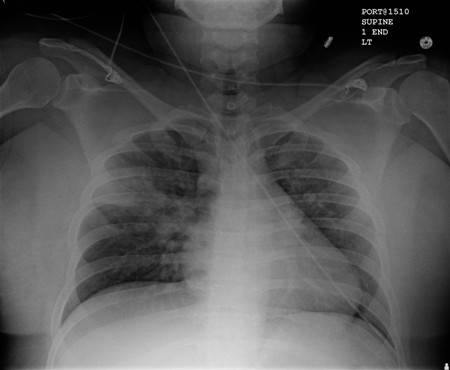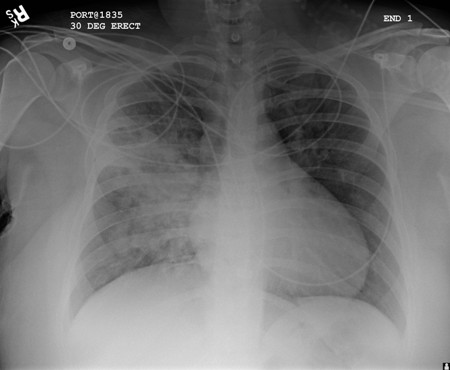Investigations
1st investigations to order
chest x-ray
Test
Order as first-line investigation for suspected aspiration pneumonia.
[Figure caption and citation for the preceding image starts]: Early ill-defined opacities of the right upper lobe above the minor fissure consistent with early changes of aspiration pneumoniaUsed with kind permission from Roy Hammond, MD [Citation ends]. [Figure caption and citation for the preceding image starts]: Increased opacification of the right perihilar region and superior segment of the right lower and upper lobes consistent with worsening aspiration pneumoniaUsed with kind permission from Roy Hammond, MD [Citation ends].
[Figure caption and citation for the preceding image starts]: Increased opacification of the right perihilar region and superior segment of the right lower and upper lobes consistent with worsening aspiration pneumoniaUsed with kind permission from Roy Hammond, MD [Citation ends].
Result
new infiltrate or atelectasis in dependent lung fields
full blood count
urea and electrolytes
Test
Recommended by the British Thoracic Society as part of the diagnostic work-up.[3]
Result
electrolytes may be deranged
liver function tests (LFTs)
Test
Recommended by the British Thoracic Society as part of the diagnostic work-up.[3]
Abnormal LFTs are common in community-acquired pneumonia.
Result
low albumin or raised alanine aminotransferase (ALT) are indicators of a higher mortality, or prolonged hospital admission
C-reactive protein (CRP)
sputum Gram stain
Test
Always send a sputum sample for Gram stain where possible. This requires an adequate specimen (i.e., uncontaminated by saliva), which may be difficult to obtain.
Gram stain result is often inconclusive, although occasionally it may verify the infecting organism.
Result
WBCs and mixed organisms
sputum culture
Test
Always send a sputum sample for culture where possible. Anaerobes are difficult to culture and require a specimen from the distal lung. Results may guide antibiotic therapy if organism identification and sensitivities are available.
Result
oral flora
Investigations to consider
arterial blood gas
Test
Consider if there is worsening oxygenation, increased work of breathing, and other systemic signs of organ dysfunction.
Result
decreased oxygen saturation and acidosis if patient moderately to severely unwell
bronchoscopy
Test
A common sampling technique is bronchoalveolar lavage.
Bronchoscopic-protected specimen brush samples, the method whereby one obtains anaerobic cultures, are not commonly performed in clinical practice.
Limited to removal of large particulate matter or a foreign body when present, or if lobar collapse is suspected as a cause of airway obstruction.[65]
Result
aerobic respiratory culture
Use of this content is subject to our disclaimer